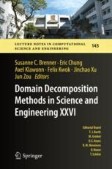Search
Search Results
-
Diffeomorphic Shape Matching by Operator Splitting in 3D Cardiology Imaging
We develop an operator splitting approach to solve diffeomorphic matching problems for sequences of surfaces in three-dimensional space. The goal is...

-
Electromechanical In Silico Testing Alters Predicted Drug-Induced Risk to Develop Torsade de Pointes
Torsade de Pointes (TdP) is a type of ventricular tachycardia that can occur as a side effect of several medications. The Comprehensive in vitro...
-
Non-Invasive Detection of Fetal Ischemia Through Electrocardiography
During pregnancy, fetal distress requiring clinical intervention can be difficult to accurately monitor and diagnose, necessitating technological...
-
Augmentation of Cardiac Ischemic Geometry for Improving Machine Learning Performance in Arrhythmic Risk Stratification
Ventricular arrhythmias frequently occur as a complication of myocardial infarction (MI), due to significant changes in the heart’s structure and...
-
Investigating the Multiscale Impact of Deoxyadenosine Triphosphate (dATP) on Pulmonary Arterial Hypertension (PAH) Induced Heart Failure
2-deoxy-ATP (dATP) is a myosin activator known to improve cardiac contractile force [1]. In vitro studies have shown that dATP alters the calcium...
-
A mathematical model of the human heart suitable to address clinical problems
In this paper, we present a mathematical model capable of simulating the human cardiac function. We review the basic equations of the model, their...

-
Identifying Ionic Channel Block in a Virtual Cardiomyocyte Population Using Machine Learning Classifiers
Immature cardiomyocytes, such as those obtained by stem cell differentiation, have been shown to be useful alternatives to mature cardiomyocytes,...
-
SemClinBr - a multi-institutional and multi-specialty semantically annotated corpus for Portuguese clinical NLP tasks
BackgroundThe high volume of research focusing on extracting patient information from electronic health records (EHRs) has led to an increase in the...

-
Heart Failure Prediction Using Supervised Machine Learning Algorithms
The heart is the second most important organ of the human body after the brain, and it circulates blood and supplies all of the body’s organs....
-
Prediction of Heart Disease Using Various Data Analysis and Machine Learning Techniques
With the ever-evolving computing technologies, the machines are learning more and more from the data they work with. A wide range of machine...
-
Recapitulating Functional Heterogeneity in Electrophysiologically Active Tissues
Inter-cellular heterogeneity is central to the dynamic range and robustness of function in many tissues, particularly electrically excitable tissues....
-
Evaluating the Usefulness of Binary Classifier Based on Enhanced ROC Analysis
The definition of the usefulness of the binary classifier from the point of view of reducing the a priori risk of false classification is formulated....
-
Quantitative Analysis of Nonlinear Multifidelity Optimization for Inverse Electrophysiology
Reliable cardiac excitation predictions depend not only on accurate geometric and physiological models, usually formulated as PDEs, and our ability...
-
Re-Introducing the Cell: The Extracellular-Membrane-Intracellular (EMI) Model
As mentioned earlier, the bidomain system is currently the standard mathematical model of cardiac electrophysiology. This system is nowroutinely...
-
Optimization for Surgery Department Management: An Application to a Hospital in Naples
Surgery department with its operating rooms represents the financial backbone of modern hospitals accounting the main part of a hospital cost and...
-
Pre-assessment of Machine Learning Approaches for Patient Length of Stay Prediction
Patient length of stay (LOS) in ICU and hospital’s general care unit is one of the important indicators that is widely measured and benchmarked to...
-
Operator Splitting and Finite Difference Schemes for Solving the EMI Model
We want to be able to perform accurate simulations of a large number of cardiac cells based on mathematical models where each individual cell is...
-
Reconstruction of a Pancreatic Beta Cell Network From Heterogeneous Functional Measurements
Intercellular heterogeneity is fundamental to most biological tissues. For some cell types, heterogeneity is thought to be responsible for distinct...
-
Membrane Models
In the previous chapters, we introduced techniques that can be used to find numerical solutions of differential equations. The examples we considered...
-
An Automated Cardiac Constitutive Modelling Framework with Evolutionary Strain Energy Functions
Heart disease is the leading cause of mortality worldwide. Many cardiac diseases are associated with altered elastic energy relations of the heart...
